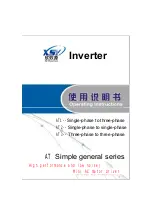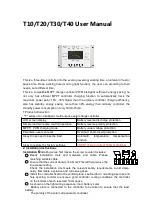
5
EN
ES
IT
PT
RO
TR
A
ppendi
x
4. OPERATION
4.1 Protections and automatic restarts
4.1.1 Overload
Some loads like motors or pumps draw large inrush currents during start-up. In such circumstances, it is possible that the start-up
current exceeds the over current limit of the inverter. In this case the output voltage will quickly decrease to limit the output current of the
inverter. If the over current limit is continuously exceeded, the inverter will shut down for 30 seconds and then automatically restart.
After three restarts followed by overload within 30 seconds of restarting, the inverter will shut down and remain off. To restart normal
operation, disconnect the load, Switch Off the inverter, then switch it On.
4.1.2 Low battery voltage thresholds (adjustable in VictronConnect)
The inverter will shut down when the DC input voltage drops below the low battery shutdown level. After a minimum shutdown time of
30 seconds, the inverter will restart if the voltage has risen above the low battery restart level.
After three shut down and restarts, followed by a low battery shutdown within 30 seconds of restarting, the inverter will shut down and
stop retrying based on the low battery restart level. To override this and restart the inverter, switch it Off, and then On, and limit loads to
enable recharging of the battery with solar energy.
The solar MPPT will continue to recharge the battery even when the inverter has shut down due to low battery voltage.
If the inverter has shut down 4 times, it will again attempt to switch itself back on as soon as the DC voltage stays above the Charge
Detect level for 30 seconds.
See the Technical Data table for default low battery shut down, restart and charge detect levels. They can be adjusted with
VictronConnect (computer or app).
Additionally another external MPPT or battery charger can also be used to recharge the battery to reach the Restart Voltage or Charge
Detect voltage level.
!!! If using the allow to charge signal functionality, it must remain above the minimum voltage, so if the battery is completely dead it will
not allow charging to start. In this case, you can temporarily disable this function in VictronConnect to allow charging to resume, then
enable it again.
See the Technical Data table for default low battery shut down and restart levels. They can be changed with VictronConnect (computer
or app).
Alternatively Dynamic Cut-off can be implemented, see
https://www.victronenergy.com/live/ve.direct:phoenix-inverters-dynamic-cutoff
4.1.3 High battery voltage
Reduce DC input voltage and/or check for a faulty battery- or solar-charger in the system. After shutting down due to a high battery
voltage, the inverter will first wait 30 seconds and then retry operation as soon as the battery voltage has dropped to acceptable level.
4.1.4 High temperature
A high ambient temperature or enduring high load may result in shut down to over temperature. The inverter will restart after 30
seconds. The inverter will continue to try and resume operation, and will not stay off after multiple retries. Reduce load and/or move
inverter to better ventilated area.
4.2 Device display
The inverter has an LCD screen that displays operational information.
Inverter:
Inverter state, Power output, Frequency and AC Voltage
Battery:
Battery Power (charging shows positive number, discharging shows negative number), Current, DC voltage, Temperature (*),
State-of-charge (*) and Time-to-go (*). Battery state (e.g. discharging, bulk, absorption, float, etc).
(*) These items are only visible if the data is available.
Solar:
Solar Power, Voltage and Current, kWh daily and total Yield.








































